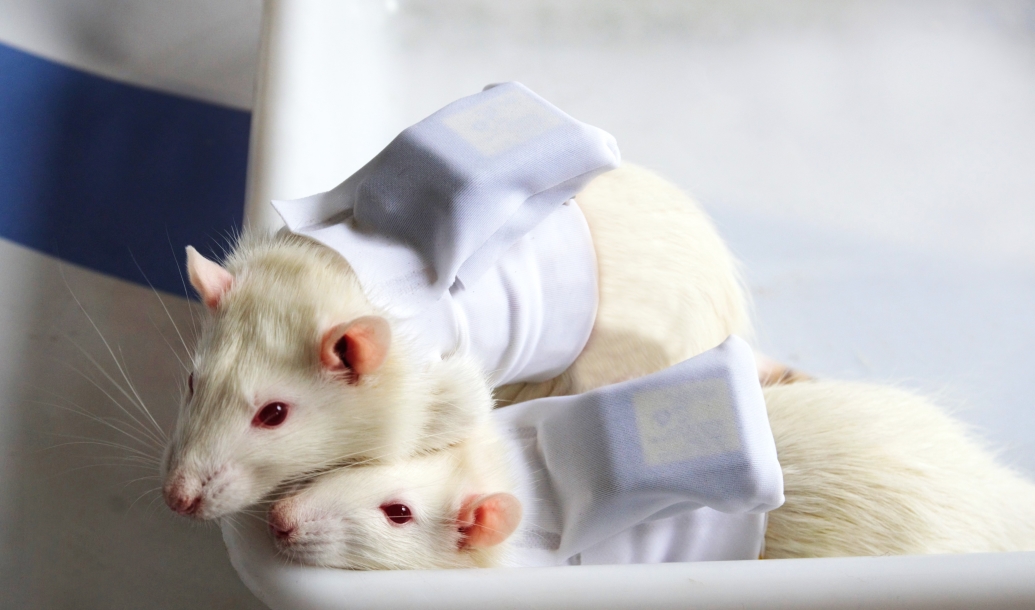Monitoring of vital functions
An effective approach to monitor health recovery or anticipate Human Endpoints after a surgery or a medical condition
Why it is important?
Most of vital function monitoring solutions primarily focus on intra-operative use, leading to a critical gap in physiological data once the animal recovers from surgery. Wearable telemetry closes this gap by enabling continuous, restraint-free, and non-invasive Home Cage Monitoring (HCM) of vital functions of the animals when they return from the operating room.
This approach enables researchers to monitor recovery of anesthesia on cardiac and respiratory function, alongside locomotor activity recovery, for extended durations from any location. This extended post-operative surveillance significantly reduces risk for the animal and facilitates early intervention by animal carers and veterinarians.
This approach allows for:
Monitoring of awakening following anesthesia: Monitoring of heart rate and respiratory rate as well as animal behavior (through activity intensity) after surgery with anesthesia for extended periods (12 to 24 hours).
Remote monitoring tracking: Remote access to vital signs of animals recovering from surgery, from the office or from home (VPN required).
Alerts : Configuration of physiological values to trigger alerts in case of alarming cardiorespiratory values.
Enhances animal welfare: Support animal care and early intervention.

Use Cases
Interested in real-time, non-invasive monitoring ?
Intraoperative Monitoring
DECRO external telemetry can be used during surgery to monitor heart rate and respiratory rate in real time. This allows researchers to assess the animal’s health status and adjust anesthesia as needed.
Supporting Humane Endpoints
At the request of ethics committees, DECRO telemetry can help anticipate humane endpoints in animals that have undergone severe procedures, by continuously tracking physiological signs that indicate distress or deterioration.
Continuous Monitoring in the Home Environment
DECRO telemetry enables 24 to 48 hours of continuous monitoring of vital functions in rats housed in their cages, as well as in mini-pigs or dogs in their home pens.
Animals can be accommodated in pairs during recordings, maintaining natural housing conditions while collecting high-quality physiological data.
Resources on Vital Functions Monitoring
Hemodynamic monitoring with thoracocardiography: Validation by beta-adrenergic modulation in anesthetized rats
Leandro Fontana Pires1,2, Agathe Cambier2, Stéphane Tanguy1, Charles Eynard2, Timothé Flenet2, Pierre-Yves Gumery1, François Boucher1 ¹ PRETA TEAM, TIMC IMAG, 38706 La Tronche CEDEX, France;² R&D, ETISENSE SAS, 69008 LYON, France...
A unifying method to study respiratory sinus arrhythmia dynamics implemented in a new toolbox
Valentin Ghibaudo,¹ Jules Granget,¹,³ Matthias Dereli,¹ Nathalie Buonviso,¹,² and Samuel Garcia¹,² ¹Centre de Recherche en Neuroscience de Lyon, Lyon, 69500, France²Centre National de la Recherche Scientifique, Lyon, 69500, France³Institut National de la Santé et de...
Marmoset (a small size NHP): Incorporation of safety pharmacology endpoints in toxicology studies
Marmoset (a small size NHP): Incorporation of safety pharmacology endpoints in toxicology studiesRaafat Fares and Pascal Champéroux European Research Biology Center (ERBC), Baugy, France Safety Pharmacology Society Annual Meeting, 2023 Abstract The common marmoset...
Non-Invasive Monitoring Of Cardiac Output: Validation In Anesthetized Laboratory Rats By Pharmacological Beta-Adrenergic Pathway Modulation
Non-Invasive Monitoring Of Cardiac Output: Validation In Anesthetized Laboratory Rats By Pharmacological Beta-Adrenergic Pathway ModulationLeandro Fontana Pires1,2, Agathe Cambier2, Stéphane Tanguy1, Charles Eynard2, Timothé Flenet2, Pierre-Yves Gumery1, François...
Explore Other Applications
Phenotyping of disease models
Monitoring of ECG morphological changes, ventilation, and locomotor activity patterns changes to better characterize pathological phenotypes and understand underlying pathophysiological mechanisms.
Pharmacology and safety-toxicology
Assessment of the efficacy and toxicity of novel pharmacological compounds on cardiorespiratory and central nervous system (CNS) functions in rodent and non-rodent species using jacketed telemetry.
Education and Training
Learn physiology and pharmacology using jacketed telemetry on rehomed animals, or through a new digital approach with pre-recorded, on-demand datasets from cardiorespiratory studies.
Veterinary
Use wearable telemetry to monitor vital signs (heart and respiratory rates) or the development of medical conditions (e.g., cardiopathy), either at home or at the veterinary clinic.




